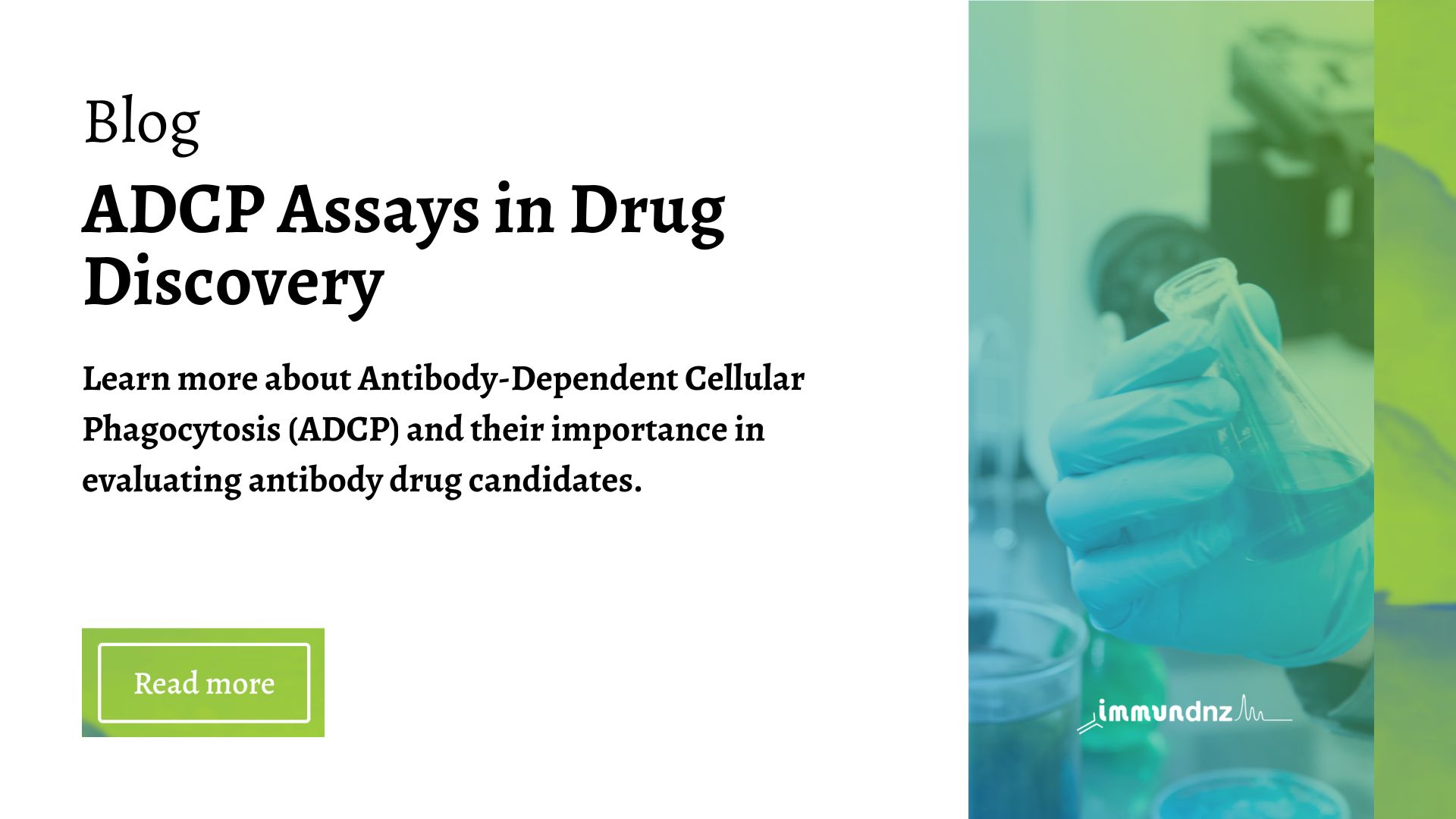Antibody-dependent cellular phagocytosis (ADCP) is a vital immune mechanism that involves the engulfment and digestion of antibody-coated cells by phagocytes such as macrophages, monocytes, and dendritic cells. This process is crucial for clearing pathogens and diseased cells, making it an important consideration in the development of therapeutic antibodies. In drug discovery, ADCP assays are essential for evaluating the functional activity of antibody candidates, particularly for cancer and infectious disease therapies. We will explain the principles of ADCP, its significance in drug discovery, the various methodologies used in ADCP assays, and the challenges and advancements in this field.
Principle of ADCP
ADCP is a multi-step process involving the following key stages:
1. Antibody Binding: Therapeutic antibodies bind to specific antigens on the surface of target cells, such as cancer cells or pathogen-infected cells.
2. Phagocyte Recognition: The Fc region of the bound antibodies interacts with Fc gamma receptors (FcγR) on the surface of phagocytic cells, predominantly FcγRIIa.
3. Engulfment: This interaction activates the phagocytes, leading to the engulfment of the antibody-coated target cells into phagosomes.
4. Digestion: The phagosomes fuse with lysosomes, where the ingested material is degraded by lysosomal enzymes.
The efficiency of ADCP depends on several factors, including the affinity of the antibody for FcγR, the density of antigen expression on target cells, and the functional state of the phagocytes.
Importance of ADCP in Drug Discovery
ADCP plays a significant role in the therapeutic efficacy of monoclonal antibodies, particularly in oncology and infectious diseases. Evaluating ADCP activity in drug discovery is crucial for several reasons:
1. Efficacy Assessment: ADCP assays help determine the ability of candidate antibodies to mediate the phagocytic clearance of target cells, providing an early indication of therapeutic potential.
2. Optimization of Antibody Engineering: Modifications to the Fc region of antibodies can enhance their binding affinity to FcγRs, thereby improving ADCP activity. Assays are essential to assess the impact of these modifications.
3. Comparative Studies: ADCP assays allow for the comparison of different antibody candidates to identify the most potent ones.
4. Safety Evaluation: Assessing ADCP helps ensure that therapeutic antibodies selectively target diseased cells without causing excessive damage to normal cells.
Types of ADCP Assays
Several methods are employed to measure ADCP activity, each with its advantages and limitations.
1. Microscopy-Based Assays:
– Principle: Phagocytosis is visualized using microscopy, where target cells are labeled with fluorescent dyes or tagged with fluorescent proteins. Phagocytic cells that have engulfed target cells can be identified and quantified.
– Advantages: Provides visual confirmation of phagocytosis, allows for the assessment of morphological changes.
– Limitations: Labor-intensive, requires sophisticated imaging equipment, and is not easily scalable for high-throughput screening.
2. Flow Cytometry-Based Assays:
– Principle: Target cells are labeled with fluorescent dyes, and phagocytosis is measured by detecting the increase in fluorescence within the phagocytes. Effector and target cells can be distinguished using specific markers.
– Advantages: Quantitative, high-throughput capability, and allows for detailed analysis of cell populations.
– Limitations: Requires flow cytometry expertise and equipment, potential for dye dilution over time.
3. Luminescence-Based Assays:
– Principle: Target cells are engineered to express a luminescent reporter gene (e.g., luciferase). The phagocytosis of target cells results in a decrease in luminescence, which is measured using a luminometer.
– Advantages: High sensitivity, non-radioactive, amenable to high-throughput screening.
– Limitations: Requires genetic modification of target cells, potential variability in reporter expression.
4. Radioactive Labeling Assays:
– Principle: Target cells are labeled with radioactive isotopes. Phagocytosis is quantified by measuring the radioactivity within the phagocytes.
– Advantages: Established and sensitive method.
– Limitations: Radioactive hazards, labor-intensive, and requires specialized equipment.
Assay Development
When developing ADCP assays, several factors must be considered to ensure reliable and reproducible results:
1. Phagocyte Source: Primary macrophages, monocytes, or dendritic cells can be used. Primary cells are more physiologically relevant, while cell lines offer consistency and ease of use.
2. Effector to Target (E:T) Ratio: The ratio of phagocytes to target cells is critical. An optimal E:T ratio must be determined to balance sensitivity and specificity.
3. Antibody Concentration: The concentration of therapeutic antibodies must be optimized to reflect therapeutic levels and ensure meaningful assessment of ADCP activity.
4. Fc Receptor Polymorphisms: Variability in FcγR expression and polymorphisms can affect ADCP activity. Using phagocytes with well-characterized FcγR profiles is essential.
Challenges and Future Directions
Despite the importance of ADCP assays in drug discovery, several challenges remain:
1. Complexity and Variability: ADCP involves multiple cell types and interactions, leading to variability in assay results. Standardizing assay conditions and using well-characterized reagents can mitigate this issue.
2. In Vivo Relevance: In vitro ADCP assays may not fully capture the complexity of in vivo immune responses. Bridging in vitro findings with in vivo models is necessary for a comprehensive evaluation.
3. Phagocyte Availability: Sourcing primary phagocytes can be challenging and variable. Phagocyte cell lines provide a consistent alternative but may not fully replicate primary cell responses.
Advancements:
– High-Throughput Screening (HTS): Development of HTS-compatible ADCP assays can accelerate the identification and optimization of therapeutic antibodies.
– Advanced Imaging Techniques: High-resolution imaging techniques, such as live-cell imaging, can provide detailed insights into the dynamics of ADCP at the single-cell level.
– Three-Dimensional (3D) Culture Systems: Incorporating 3D culture systems and organoids can offer more physiologically relevant models for studying ADCP.
– Single-Cell Analysis: Technologies such as single-cell RNA sequencing (scRNA-seq) can provide detailed information on the transcriptional changes in phagocytes during ADCP, leading to a better understanding of the mechanisms involved.
Conclusion
ADCP assays are indispensable tools in the field of drug discovery, especially for the development of monoclonal antibodies aimed at treating cancer and infectious diseases. These assays provide crucial insights into the functional activity of therapeutic antibodies by assessing their ability to mediate the phagocytic clearance of diseased cells. Despite the challenges associated with ADCP assays, ongoing advancements in assay technologies and methodologies continue to enhance their relevance and application in drug discovery. By understanding and leveraging ADCP, more effective and targeted therapies can be developed, ultimately improving patient outcomes.


